Fueled by Kindness
Good Hearts & Hard Work Move Mountains (or at least fix them when they fall down…)
So much in life can’t happen without the kindness of others, and this is especially true here in the Himalayas.
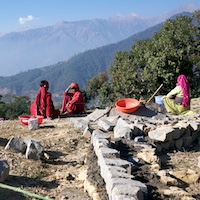 In a “subsistence-plus” economy such as we have here in Himachal Pradesh, most villagers have enough land to feed their families, more or less, so they don’t necessarily need to work for anyone but themselves in order to survive. Like their fellow humans across the globe, though, modern Himalayan villagers seek more than mere survival. They want some comfort and convenience, and they want a better life for their children.
In a “subsistence-plus” economy such as we have here in Himachal Pradesh, most villagers have enough land to feed their families, more or less, so they don’t necessarily need to work for anyone but themselves in order to survive. Like their fellow humans across the globe, though, modern Himalayan villagers seek more than mere survival. They want some comfort and convenience, and they want a better life for their children.
The costs of staple foods, fuel, and energy are rising continually and, these days, a lot of the locals also want an addition to their home and an upgrade from bicycle to scooter to motorcycle to car — maybe even an iPhone. Even in the enchanted forests of the Himalayas, these things don’t grow on trees. If you want anything more than you can grow on your own land, you’ll need to find paid work. For all of these reasons, most of the villagers here must look for outside jobs.
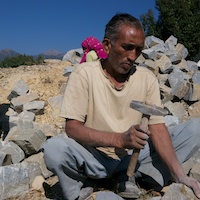 Even so, they don’t show up for work just because you pay them. If these dignified Himalayan villagers leave their own land to work for someone else, it’s not only because the wages are compelling, but also because they think the work itself is worth doing and they have a reasonable degree of respect for the people with whom and for whom they’re working. Otherwise, most self-respecting Himachalis would sooner stay home (and, truth be told, they often do, as anyone who has tried to build or repair something here will attest).
Even so, they don’t show up for work just because you pay them. If these dignified Himalayan villagers leave their own land to work for someone else, it’s not only because the wages are compelling, but also because they think the work itself is worth doing and they have a reasonable degree of respect for the people with whom and for whom they’re working. Otherwise, most self-respecting Himachalis would sooner stay home (and, truth be told, they often do, as anyone who has tried to build or repair something here will attest).
So, in such a climate, what happens when the work to be done is even more difficult than usual, the location remote, and the conditions somewhat unreasonable? And what if the one who needs the work done is a nonprofit organization with a sandal-strap budget and a mountain to scale?
Well, it all comes down to kindness.
 Take our recent avalanche, for example. This past August, exceptionally heavy monsoon rains triggered a massive landslide that knocked out over 300 feet (nearly 100 meters) of our access road — the road we’d spent most of last spring building so that we’d be able to bring in large stones, bamboo, and other building materials that aren’t available at the building site of the Dharmalaya Institute. Without the road, we couldn’t resume construction and, judging by the extent of the damage, it appeared we might fall weeks or even months further behind schedule. Such a delay simply was not an option, since Mama Nature imposes an inflexible deadline for mud-based construction in South Asia: Get the roof on your building before the start of the monsoon rains in June or everything you’ve built melts back into the earth like a sand castle at high tide. Our budget was already overstretched, and there was no way we could afford to rebuild the road with enough cash left to finish the building, and yet we couldn’t even take the next step without the road, so we needed a small miracle.
Take our recent avalanche, for example. This past August, exceptionally heavy monsoon rains triggered a massive landslide that knocked out over 300 feet (nearly 100 meters) of our access road — the road we’d spent most of last spring building so that we’d be able to bring in large stones, bamboo, and other building materials that aren’t available at the building site of the Dharmalaya Institute. Without the road, we couldn’t resume construction and, judging by the extent of the damage, it appeared we might fall weeks or even months further behind schedule. Such a delay simply was not an option, since Mama Nature imposes an inflexible deadline for mud-based construction in South Asia: Get the roof on your building before the start of the monsoon rains in June or everything you’ve built melts back into the earth like a sand castle at high tide. Our budget was already overstretched, and there was no way we could afford to rebuild the road with enough cash left to finish the building, and yet we couldn’t even take the next step without the road, so we needed a small miracle.
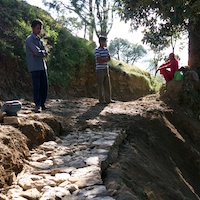 “No problem,” said Chohan Singh Diman, a local builder. Now, these are words one learns to take with a generous pinch of Himalayan rock salt in this neck of the woods, but Chohan took things seriously, with attention to detail, in a way that engendered confidence. We surveyed the landslide for over an hour and Chohan formulated a plan for the gradual rehabilitation of the road, starting with first aid to restore the road to a minimally serviceable state that would allow a tractor to carry the urgently needed materials to the top ASAP, with further reinforcement and improvements to come later. To accommodate both our limited budget and the urgency of the need, Chohan kindly offered a discounted bid and simply asked that we give him more work in the future so he could gradually earn back the difference. He quickly assembled a team of half a dozen local laborers and made short work of clearing the landslide debris and building stone retaining walls across the landslide area to support a new road. Just over a week later, to our great relief (and some astonishment), the tractor was able to haul the cut stones for our plinth all the way up the hill to the construction site.
“No problem,” said Chohan Singh Diman, a local builder. Now, these are words one learns to take with a generous pinch of Himalayan rock salt in this neck of the woods, but Chohan took things seriously, with attention to detail, in a way that engendered confidence. We surveyed the landslide for over an hour and Chohan formulated a plan for the gradual rehabilitation of the road, starting with first aid to restore the road to a minimally serviceable state that would allow a tractor to carry the urgently needed materials to the top ASAP, with further reinforcement and improvements to come later. To accommodate both our limited budget and the urgency of the need, Chohan kindly offered a discounted bid and simply asked that we give him more work in the future so he could gradually earn back the difference. He quickly assembled a team of half a dozen local laborers and made short work of clearing the landslide debris and building stone retaining walls across the landslide area to support a new road. Just over a week later, to our great relief (and some astonishment), the tractor was able to haul the cut stones for our plinth all the way up the hill to the construction site.
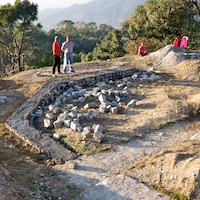 We were back in action but now a couple of weeks behind, with nature’s clock ticking audibly, so next up was the challenge of organizing an accelerated construction schedule during the busiest time of the year, when both fall harvests and an astrologically ordained six-week parade of three-day weddings keep most of the village’s labor force preoccupied with fields and family. Here again, we were saved by the kindness and wisdom of our beloved friend and renowned eco-architect, Didi Contractor, and her talented (and charming) crew of green builders from Sidhbari (Naresh, Kaka, Rooplal, Bali, and Kamlesh), who repeatedly made the two-hour trek to Bir to contribute their seasoned ingenuity to solving our puzzle. Soberly assessing the circumstances and limited local resources, they helped us piece together a plan to start where we were and get where we need to be in the shortest possible time (relying heavily on a generous jump-start from our Sidhbari gurus working on-site and training our local laborers).
We were back in action but now a couple of weeks behind, with nature’s clock ticking audibly, so next up was the challenge of organizing an accelerated construction schedule during the busiest time of the year, when both fall harvests and an astrologically ordained six-week parade of three-day weddings keep most of the village’s labor force preoccupied with fields and family. Here again, we were saved by the kindness and wisdom of our beloved friend and renowned eco-architect, Didi Contractor, and her talented (and charming) crew of green builders from Sidhbari (Naresh, Kaka, Rooplal, Bali, and Kamlesh), who repeatedly made the two-hour trek to Bir to contribute their seasoned ingenuity to solving our puzzle. Soberly assessing the circumstances and limited local resources, they helped us piece together a plan to start where we were and get where we need to be in the shortest possible time (relying heavily on a generous jump-start from our Sidhbari gurus working on-site and training our local laborers).
 Central to this plan is the formidable challenge of incubating a skilled green building crew locally, where none currently exists. And, in this, we would’ve had no chance at all to succeed without the considerable kindness and generosity of several people who answered the call and then some. Our committed local partners (and Dharmalaya board members) Ravi, Savita, and Jaswant Paul have made critical contributions in facilitating logistics and offering guidance at every turn.
Central to this plan is the formidable challenge of incubating a skilled green building crew locally, where none currently exists. And, in this, we would’ve had no chance at all to succeed without the considerable kindness and generosity of several people who answered the call and then some. Our committed local partners (and Dharmalaya board members) Ravi, Savita, and Jaswant Paul have made critical contributions in facilitating logistics and offering guidance at every turn.
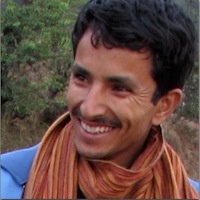 And one of the brightest rising stars on our hilly horizon is shining in the form of one Raj Kumar (“Raju”), Dharmalaya’s first full-time employee, who originally joined us as a taxi driver providing occasional help with logistics and then impressed us all by rising to the challenge of stepping into the key role of foreman-in-training for our entire eco-building project. To say that Raju has gone the extra kilometer would be understating things by about a light year. We’re all pleased to witness both his enthusiastic interest and his capacity to learn and take on responsibilities and manage them well. As our friends from Sidhbari observed, it is rare and precious to find a young person with such a keen interest and aptitude for learning the arts of high-quality traditional building, so we intend to make the most of this win-win gift by providing him with training from the best green builders in Himachal (namely, Didi and her team) so that, in concert with them, we can work to preserve that local wisdom and spread it near and far.
And one of the brightest rising stars on our hilly horizon is shining in the form of one Raj Kumar (“Raju”), Dharmalaya’s first full-time employee, who originally joined us as a taxi driver providing occasional help with logistics and then impressed us all by rising to the challenge of stepping into the key role of foreman-in-training for our entire eco-building project. To say that Raju has gone the extra kilometer would be understating things by about a light year. We’re all pleased to witness both his enthusiastic interest and his capacity to learn and take on responsibilities and manage them well. As our friends from Sidhbari observed, it is rare and precious to find a young person with such a keen interest and aptitude for learning the arts of high-quality traditional building, so we intend to make the most of this win-win gift by providing him with training from the best green builders in Himachal (namely, Didi and her team) so that, in concert with them, we can work to preserve that local wisdom and spread it near and far.
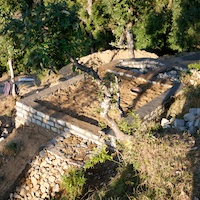 As it stands now, we’re nearing completion of the plinth (the stone base of the building, above the foundations and below the floor and walls) and, after a couple of weeks, when we’ve laid a few more courses of stones to raise the walls to the level of the window sills, we’ll begin setting up the molds for the rammed-earth portion of the walls. Meanwhile, we’re also midway into the construction of our first mud hut, which will serve as a dry and secure place to store our tools and materials and will finally allow some of us to stay on site rather than commuting daily from the town of Bir. So, we’re catching up, and so far we’ve created about 18 green jobs to make it all happen, with more on the way. It’s inspiring to see it all coming together. (And we’re documenting everything with photos and videos and will be posting to the Earthville blog and to YouTube and Flickr.)
As it stands now, we’re nearing completion of the plinth (the stone base of the building, above the foundations and below the floor and walls) and, after a couple of weeks, when we’ve laid a few more courses of stones to raise the walls to the level of the window sills, we’ll begin setting up the molds for the rammed-earth portion of the walls. Meanwhile, we’re also midway into the construction of our first mud hut, which will serve as a dry and secure place to store our tools and materials and will finally allow some of us to stay on site rather than commuting daily from the town of Bir. So, we’re catching up, and so far we’ve created about 18 green jobs to make it all happen, with more on the way. It’s inspiring to see it all coming together. (And we’re documenting everything with photos and videos and will be posting to the Earthville blog and to YouTube and Flickr.)
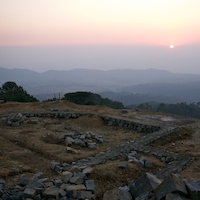 Without a doubt, we simply could not be doing what we’re doing without the kindness of these big-hearted people, and others like them who are playing their parts to make this possible. It strikes us many times every day that this mothership runs entirely on kindness — it’s the fuel and the fabric of all that’s happening. We feel deeply grateful for our team, our laborers, our building gurus, our donors, and all the many forms of support that are coalescing around this effort, and we feel fortunate to be a part of this love-driven global community barn-raising adventure.
Without a doubt, we simply could not be doing what we’re doing without the kindness of these big-hearted people, and others like them who are playing their parts to make this possible. It strikes us many times every day that this mothership runs entirely on kindness — it’s the fuel and the fabric of all that’s happening. We feel deeply grateful for our team, our laborers, our building gurus, our donors, and all the many forms of support that are coalescing around this effort, and we feel fortunate to be a part of this love-driven global community barn-raising adventure.
And we warmly invite you to be a part of it, too! Here are a few ways you can participate:
- VOLUNTEER: Come to Bir (in northern India) this spring or autumn to volunteer for the “barn raising.” › details
- DONATE: Make a charitable donation to support our eco-construction and the green jobs it creates (tax-deductible in the US and India). › details
- SPONSOR TREES: Offset your carbon emissions for the year, while creating more green jobs, by sponsoring tree plantings in the Earthville Orchards currently at just $2 US per tree (also tax-deductible). › details
- SPREAD THE WORD: Forward this story to your friends, post it on your blog, share this story on Facebook and “like” the Earthville and Dharmalaya FB pages, send forth a mighty tweet, or, you know, talk to people. 🙂

Beautiful! I can hardly wait to move into a hut, plant trees, and raise the barns with everyone there. 🙂 🙂 🙂
Inspiring! All the best in 2011!
Beautiful !!!